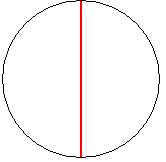Diameter
In geometry, the diameter is the line segment that passes through the center and joins two opposite points of a circle. In 3D (sphere) it is defined as the segment that passes through the center and has its ends on its surface. This notion can be extended without variations to a hypersphere of more dimensions. A notion of diameter can even be extended to figures that are not spheres, when they are subsets of an arbitrary metric space.
In many technical applications the symbol ⌀ is used for the length of the diameter. [Kirino mmg]
Diameter of a circle
Euclid of Alexandria defines the diameter thus in his treatise called Elements:
«A diameter of a circle is a straight either (segment) passing through the center and ending in both directions in the circle circumference; this straight line also divides the circle into two equal parts".Euclides of Alexandria, Elements, book I, definition 17.
The relationship between the length of the circumference and its diameter is a constant known as π (pronounced as "pi"), its value is close to 355/113 (or 3.14159...)
As in a circle the diameter measures twice the radius, the length of the circle with respect to its radius r is: 2πr.
Diameter symbol
In engineering and other technical areas, the symbol or variable for diameter is similar in size and design to ø. Unicode provides the character 8960 (hexadecimal 2300) for the symbol, which can be encoded in HTML web pages as ⌀ or ⌀. However, proper presentation of such a character is unlikely in almost all situations, since most typefaces do not include it. (Browser displays ⌀ and ⌀ in current font). Almost always ø is acceptable, obtained in Windows by pressing the [Alt] key while entering 0 2 4 8 on the numeric keypad.
It is important not to confuse the symbol for diameter (ø) with the similar but uppercase empty set symbol (Ø). The diameter is sometimes also called phi (pronounced "phi"), although this seems to come from the fact that Ø and ø resemble Φ and φ, the letter phi of the Greek alphabet.
It is abbreviated as: Diá. or D.
Diameter of an arbitrary set
In mathematics it is common to extend the notion of diameter to an arbitrary set A X{displaystyle Asubset X} inside a metric space (X,d){displaystyle (X,d),}in that context the diameter is defined as the actual number such that:
diam(A)=supx,and한 한 Ad(x,and){displaystyle {mbox{diam}}(A)=sup _{x,yin Ad}(x,y)}
The name «diameter» is due to the fact that within an irregular space the previous measurement coincides with the diameter of a circumscribed circle that contains the irregular set.
If the set whose diameter we know is a measurable set of two-dimensional Euclidean space, then we have the following relation between the area SA and the diameter:
diam(A)≥ ≥ 2SAπ π {displaystyle {mbox{diam}}(A)geq 2{sqrt {frac {S_{A}{pi }}}}}}}
The establishment of the above inequality is a classic isoperimetry problem. Another classic problem establishes a relationship between the diameter of a bounded set, and the radius of the smallest circumcircle that contains said set:
r≤ ≤ diam(A)3{displaystyle rleq {frac {{mbox{diam}}}(A)}{sqrt {3}}}}}
Equality is given for example for an equilateral triangle whose circumscribed circumference has a diameter 3/2≈ ≈ 1,1577...... {displaystyle scriptstyle {sqrt {3}/2approx 1,1577dots }. The result is a particular case of the Jung theorem that generalizes the previous result for an euclid space of any number of dimensions.
Contenido relacionado
Magic square
Enfilade (chess)
Nicolas Bourbaki









